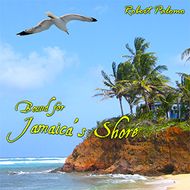After bumping into my original sea shanty Bound for Jamaica's Shore, a gent over on Facebook asked:
"What makes a song a shanty? T'is a term I am only vaguely familiar with."
 The short answer: sea shanties (sometimes written "chantys") were the working and recreational songs of sailors during the age of sail.
The short answer: sea shanties (sometimes written "chantys") were the working and recreational songs of sailors during the age of sail.
Shanties are generally very rhythmical, as they were mostly sung to help sailors keep a steady pace when hauling on halyards or heaving at a capstan. The form is usually "call and response". One voice, the "shantyman" sings different lines in the verses, and a group of voices respond with a recurring line, sometimes in harmony. There may be a chorus or refrain sung in the same way, or all together. On deck, the shantyman could be the bosun, a mate commanding a watch, or any sailor who knew all the lines of the song. The crew performing the task at hand would sing the responses as they worked.

Weighing Anchor on-Ship 'Abbie Palmer' (Penobscott Museum)
Surviving Steam Power
With the advent of steam propulsion, the great sailing ships largely disappeared, leaving only a relatively few as museum pieces and atypical vacations. The working and recreational songs of the sailors who worked the tall ships have subsided into a musical niche largely lost on the masses of music listeners. But they are not dead yet. Here are a couple of groups who are not only keeping sea songs alive, but spreading their popularity.
Santiano (Germany)
A hugely popular group in Germany, critics of Santiano say they have "popified" the sea shanty. Perhaps, but I think they capture the essential spirit of the music very well. And an evolution that appeals broadly seems better than just letting the form die out.
Bellowhead (UK)
England's Bellowhead is an 11-piece ensemble of awesome power and creativity. They take classic English folk songs and sea shanties and mould them into brilliantly arranged performances that will simply paste you to the wall. (Can you tell I'm a Bellowhead fan??) Here's an example of what I mean:
Not just English and American
While the most widely known sea shanties seem to be English, Irish, and American, there are shanties in as many languages there were seafaring nations with sailing ships. The work and the lives of the sailors were basically the same, and the songs served the same purposes no matter what the language. For example, here is a Russian one performed by the group I play with in Saint Petersburg:
Are there any new sea shanties?
The age of sail may be all but gone for now, but if there's anything left of the planet after the rapacious fossil fuel barons finally squeeze out the last drops of profit, sail will have to make a comeback in future generations. Meantime, there are folks like Sail Training International who are making sure the knowledge and skills of the seafaring past are not lost.
I feel that one of the ways to keep traditional music alive is to write new music in the same vein. That's why, after I started playing with the Shanty Choir Tallship MIR in 2014, I decided to try my hand at writing "new old sea songs". I guess the jury is still out as to whether they're worth a cod fart in a raging sou'easter, and whether any sailors of the future will heave up the anchor to one of my tunes remains to be seen. You can judge for yourself by listening to my original sea songs on this site.
